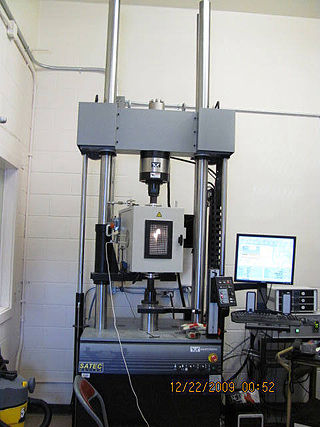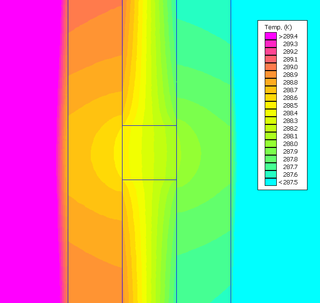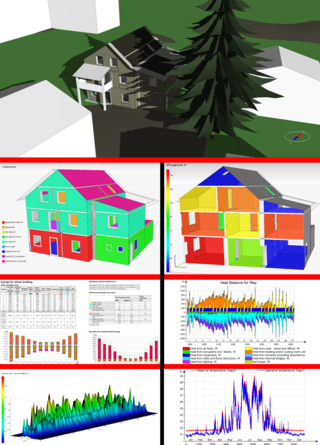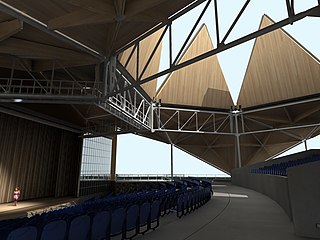Related Research Articles

Computer simulation is the process of mathematical modelling, performed on a computer, which is designed to predict the behaviour of, or the outcome of, a real-world or physical system. The reliability of some mathematical models can be determined by comparing their results to the real-world outcomes they aim to predict. Computer simulations have become a useful tool for the mathematical modeling of many natural systems in physics, astrophysics, climatology, chemistry, biology and manufacturing, as well as human systems in economics, psychology, social science, health care and engineering. Simulation of a system is represented as the running of the system's model. It can be used to explore and gain new insights into new technology and to estimate the performance of systems too complex for analytical solutions.

Passive house is a voluntary standard for energy efficiency in a building, which reduces the building's ecological footprint. It results in ultra-low energy buildings that require little energy for space heating or cooling. A similar standard, MINERGIE-P, is used in Switzerland. The standard is not confined to residential properties; several office buildings, schools, kindergartens and a supermarket have also been constructed to the standard. The design is not an attachment or supplement to architectural design, but a design process that integrates with architectural design. Although it is generally applied to new buildings, it has also been used for refurbishments.

Superinsulation is an approach to building design, construction, and retrofitting that dramatically reduces heat loss by using much higher insulation levels and airtightness than average. Superinsulation is one of the ancestors of the passive house approach.

Building science is the science and technology-driven collection of knowledge in order to provide better indoor environmental quality (IEQ), energy-efficient built environments, and occupant comfort and satisfaction. Building physics, architectural science, and applied physics are terms used for the knowledge domain that overlaps with building science. In building science, the methods used in natural and hard sciences are widely applied, which may include controlled and quasi-experiments, randomized control, physical measurements, remote sensing, and simulations. On the other hand, methods from social and soft sciences, such as case study, interviews & focus group, observational method, surveys, and experience sampling, are also widely used in building science to understand occupant satisfaction, comfort, and experiences by acquiring qualitative data. One of the recent trends in building science is a combination of the two different methods. For instance, it is widely known that occupants’ thermal sensation and comfort may vary depending on their sex, age, emotion, experiences, etc. even in the same indoor environment. Despite the advancement in data extraction and collection technology in building science, objective measurements alone can hardly represent occupants' state of mind such as comfort and preference. Therefore, researchers are trying to measure both physical contexts and understand human responses to figure out complex interrelationships.
Building performance is an attribute of a building that expresses how well that building carries out its functions. It may also relate to the performance of the building construction process. Categories of building performance are quality, resource savings and workload capacity. The performance of a building depends on the response of the building to an external load or shock. Building performance plays an important role in architecture, building services engineering, building regulation, architectural engineering and construction management. Furthermore, improving building performance is important for addressing climate change, since buildings account for 30% of global energy consumption, resulting in 27% of global greenhouse gas emissions. Prominent building performance aspects are energy efficiency, occupant comfort, indoor air quality and daylighting.

Building insulation is material used in a building to reduce the flow of thermal energy. While the majority of insulation in buildings is for thermal purposes, the term also applies to acoustic insulation, fire insulation, and impact insulation. Often an insulation material will be chosen for its ability to perform several of these functions at once.

A thermal bridge, also called a cold bridge, heat bridge, or thermal bypass, is an area or component of an object which has higher thermal conductivity than the surrounding materials, creating a path of least resistance for heat transfer. Thermal bridges result in an overall reduction in thermal resistance of the object. The term is frequently discussed in the context of a building's thermal envelope where thermal bridges result in heat transfer into or out of conditioned space.

An energy audit is an inspection survey and an analysis of energy flows for energy conservation in a building. It may include a process or system to reduce the amount of energy input into the system without negatively affecting the output. In commercial and industrial real estate, an energy audit is the first step in identifying opportunities to reduce energy expense and carbon footprint.
Design impact measures are measures used to qualify projects for various environmental rating systems and to guide both design and regulatory decisions from beginning to end. Some systems, like the greenhouse gas inventory, are required globally for all business decisions. Some are project-specific, like the LEED point rating system which is used only for its own ratings, and its qualifications do not correspond to much beyond physical measurements. Others like the Athena life-cycle impact assessment tool attempt to add up all the kinds of measurable impacts of all parts of a building throughout its life and are quite rigorous and complex.
Energy Management Software (EMS) is a general term and category referring to a variety of energy-related software applications which may provide utility bill tracking, real-time metering, building HVAC and lighting control systems, building simulation and modeling, carbon and sustainability reporting, IT equipment management, demand response, and/or energy audits. Managing energy can require a system of systems approach.

Variable renewable energy (VRE) or intermittent renewable energy sources (IRES) are renewable energy sources that are not dispatchable due to their fluctuating nature, such as wind power and solar power, as opposed to controllable renewable energy sources, such as dammed hydroelectricity or biomass, or relatively constant sources, such as geothermal power.
The detailed design of buildings needs to take into account various external factors, which may be subject to uncertainties. Among these factors are prevailing weather and climate; the properties of the materials used and the standard of workmanship; and the behaviour of occupants of the building. Several studies have indicated that it is the behavioural factors that are the most important among these. Methods have been developed to estimate the extent of variability in these factors and the resulting need to take this variability into account at the design stage.

Building performance simulation (BPS) is the replication of aspects of building performance using a computer-based, mathematical model created on the basis of fundamental physical principles and sound engineering practice. The objective of building performance simulation is the quantification of aspects of building performance which are relevant to the design, construction, operation and control of buildings. Building performance simulation has various sub-domains; most prominent are thermal simulation, lighting simulation, acoustical simulation and air flow simulation. Most building performance simulation is based on the use of bespoke simulation software. Building performance simulation itself is a field within the wider realm of scientific computing.

In building engineering, a climate-adaptive building shell (CABS) is a facade or roof that interacts with the variability of its environment in a dynamic way. Conventional structures have static building envelopes and therefore cannot act in response to changing weather conditions and occupant requirements. Well-designed CABS have two main functions: they contribute to energy-saving for heating, cooling, ventilation, and lighting, and they induce a positive impact on the indoor environmental quality of buildings.
A performance gap is a disparity that is found between the energy use predicted and carbon emissions in the design stage of buildings and the energy use of those buildings in operation. Research in the UK suggests that actual carbon emissions from new homes can be 2.5 times the design estimates, on average. For non-domestic buildings, the gap is even higher - actual carbon emissions as much as 3.8 times the design estimates, on average.
Sensitivity analysis identifies how uncertainties in input parameters affect important measures of building performance, such as cost, indoor thermal comfort, or CO2 emissions. Input parameters for buildings fall into roughly three categories:

The International Energy Agency Energy in Buildings and Communities Programme, formerly known as the Energy in Buildings and Community Systems Programme (ECBCS), is one of the International Energy Agency's Technology Collaboration Programmes (TCPs). The Programme "carries out research and development activities toward near-zero energy and carbon emissions in the built environment".

IDA IndoorClimate andEnergy is a Building performance simulation (BPS) software. IDA ICE is a simulation application for the multi-zonal and dynamic study of indoor climate phenomena as well as energy use. The implemented models are state of the art, many studies show that simulation results and measured data compare well.

Ventilative cooling is the use of natural or mechanical ventilation to cool indoor spaces. The use of outside air reduces the cooling load and the energy consumption of these systems, while maintaining high quality indoor conditions; passive ventilative cooling may eliminate energy consumption. Ventilative cooling strategies are applied in a wide range of buildings and may even be critical to realize renovated or new high efficient buildings and zero-energy buildings (ZEBs). Ventilation is present in buildings mainly for air quality reasons. It can be used additionally to remove both excess heat gains, as well as increase the velocity of the air and thereby widen the thermal comfort range. Ventilative cooling is assessed by long-term evaluation indices. Ventilative cooling is dependent on the availability of appropriate external conditions and on the thermal physical characteristics of the building.
Linda Opal Mearns is a geographer and climate scientist specializing in climate change assessment science. Mearns is a senior scientist at the National Center for Atmospheric Research (NCAR). Mearns is the director of NCAR's Weather and Climate Impacts Assessment Science Program (WCIASP) and head of the Regional Integrated Sciences Collective (RISC). Mearns is a lead principal investigator for the North American Regional Climate Change Program (NARCCAP).
References
- ↑ Ramallo-González, A.P. 2013. Modelling Simulation and Optimisation of Low-energy Buildings. PhD. University of Exeter.
- ↑ ODPM, 2005. Age of Commercial and Industrial Stock: Local Authority Level 2004. London: Office of the Deputy Prime Minister.
- ↑ CLG, 2007. English House Condition Survey 2007, Annual report. Communities and Local Government
- ↑ de Wilde, P. & Coley, D., 2012. The implications of a changing climate for buildings. Building and Environment, 55, pp.1-7
- ↑ Wang, L., Mathew, P. & Pang, X., 2012. Uncertainties in energy consumption introduced by building operations and weather for a medium-size office building. Energy and Buildings, 53, pp.152-158
- ↑ Eames, M., Kershaw, T. & Coley, D., 2011. The appropriate spatial resolution of future weather files for building simulation. Journal of Building Performance Simulation, 5, pp.1-12
- ↑ Wingfield, J., Bell, M., Miles-Shenton, D., South, T. & Lowe, B., 2011. Evaluating the impact of an enhanced energy performance standard on load-bearing masonry domestic construction, Understanding the gap between designed and real performance: Lessons from Stamford Brook. London: Department for Communities and Local Government
- ↑ Hopfe, C.J. & Hensen, J.L.M., 2011. Uncertainty analysis in building performance simulation for design support. Energy and Buildings, 43, pp.2798-2805
- ↑ de Wilde, P. & Tian, W., 2009. Identification of key factors for uncertainty in the prediction of the thermal performance of an office building under climate change. Building Simulation, 2, pp.157-174
- 1 2 Schnieders, J. & Hermelink, A., 2006. CEPHEUS results: measurements and occupants’ satisfaction provide evidence for Passive Houses being an option for sustainable building. Energy Policy, 34, pp.151-171
- 1 2 Blight, T.S., Coley D. A., 2012 The impact of occupant behaviour on the energy consumption of low-energy dwellings, 2nd Conference on Building Energy and Environment. Boulder, USA
- ↑ Richardson, I., Thomson, M. & Infield, D., 2008. A high-resolution domestic building occupancy model for energy demand simulations. Energy and Buildings, 40, pp.1560-1566